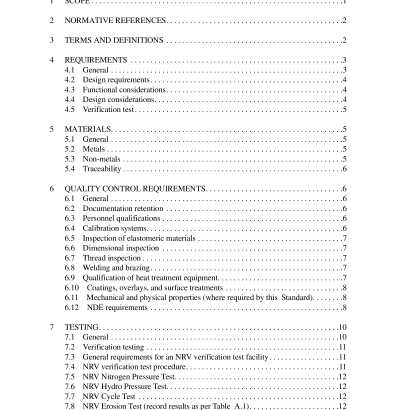API 7NRV:2020 pdf free download.Specification for Drill String Non-return Valves
4.2 DESIGN REQUIREMENTS
4.2.1 Drawings, manufacturing specifications and the verification test results shall be retained by the manufacturer for a period of ten years after NRVs of that size, model and type are discontinued from the manufacturer’s product line. NRV equipment con- forming to this Standard shall be manufactured to drawings and specifications that are substantially the same as those of the NRV equipment that has passed the verification test.
4.2.2 Documentation of designs shall include methods, assumptions, calculations and design requirements. Design require- ments shall include but not be limited to those criteria for size, test and operating pressures, material, environmental and other per- tinent requirements upon which the design is based. Design documentation shall be clear, legible, reproducible and retrievable.
4.2.3 Design documentation shall be reviewed and verified by a qualified individual other than the individual who created the original design.
4.2.4 Changes to the design acceptance criteria which may affect verification test performance or interchangeability of NRV equipment shall require re-qualification, except that seals which have passed the applicable verification test requirements of clause 7 shall be considered interchangeable among the NRV equipment of any one manufacturer for a particular class of service.
4.2.5 NRV equipment manufactured in accordance with this Standard shall conform to one or more of the following classes of service: Class 1: standard service. This class of NRV equipment is intended for use in wells which do not exhibit the detrimental effects caused by sand or corrosive agents. Class 2: stress corrosion cracking service. This class of NRV equipment is intended for use in wells where corrosive agents could be expected to cause stress corrosion cracking. Class 2 equipment shall meet the requirements for Class 1 and be manufactured from materials which are resistant to stress corrosion cracking. Within this service class, there are two divisions, 2S for sulfide stress cracking service and 2C (see note) for chloride stress cracking service. Metallic materials, selected for an H 2 S environment, shall be in accordance with NACE MR0175. Note: Metallic materials suitable for Class 2C service are dependent on specific well conditions. No national or international standards exist for the application of metallic materials for this class of service.
4.3 FUNCTIONAL CONSIDERATIONS NRV design shall permit prediction and repeatability of rates, pressures or other conditions required for operation. 4.4 DESIGN CONSIDERATIONS
4.4.1 The manufacturer shall establish rated working pressures of NRV equipment within the requirements of this Standard. These rated working pressures are commonly 34,5 Mpa, 51,7 Mpa, and 68,9 Mpa (5 ,000 psi, 7,500 psi, and 10,000 psi). Temper- ature effects on all the materials used in the manufacture of NRV equipment shall be considered in establishing the rated working pressure. The design shall take into account the effects of pressure containment and pressure-induced loads. Specialized condi- tions shall also be considered such as pressure testing with temporary test plugs. See 8.1 for pressure identification coding.
4.4.2 The manufacturer shall establish internal yield pressure, collapse pressure and minimum tensile strength ratings, exclud- ing end connections.
4.4.3 NRV equipment design shall take into consideration the effects of temperature gradients and thermal cycles on all compo- nents. The upper temperature limit shall be the lowest high-temperature rating of any component of the NRV. The lower tempera- ture limit shall be the highest low-temperature rating of any component of the NRV. Derating of metal mechanical properties shall be in accordance with ASME Boiler and Pressure Vessel Code Section II, Part D, Material Properties.
4.4.4 NRV equipment design shall take into account the effects of retained fluid(s) on all components. NRV equipment design shall consider the effects of sand, chlorides, corrosion inhibitors and other chemicals routinely encountered in oil and gas produc- tion and drilling operations.
4.4.5 Component and subassembly interchangeability shall be required within each manufacturer’s service class, size, type and model, including pressure rating of NRV equipment. This shall extend to all facilities of the manufacturer. Components shall be designed or identified to avoid the use of non-interchangeable parts. See marking categories, 8.1, for pressure ratings.API 7NRV pdf download.API 7NRV:2020 pdf free download
